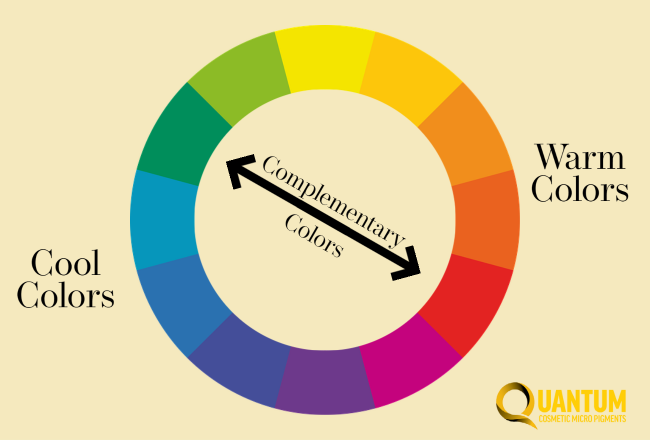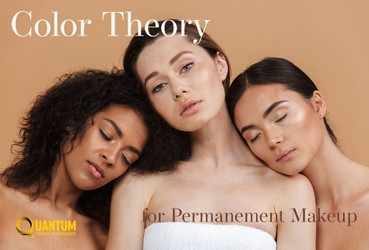Color Theory for Permanent Makeup
Dec 21st 2021
Trying to wrap your head around color theory and how it relates to permanent makeup can be a daunting task. However, understanding how colors interact with one another and how they work with different skin tones is essential to achieving optimal results when applying permanent makeup. There are two basic concepts of color theory that are crucial to choosing the appropriate colors for PMU and for color correction: The Color Wheel and the Fitzpatrick Scale.
What is the color wheel?
The color wheel, or color circle, dates back to the 1704 work Opticks by Isaac Newton. It is
used to illustrate the relationship between primary and secondary colors and
has been used as the basis of color theory for centuries. Painters, graphics designers, hair color
experts, and PMU artists alike use the color wheel to make decisions when it
comes to color. The wheel is laid out to
emphasize a few key points in color theory:
Primary/Secondary Colors: The three primary colors red, blue, and yellow are spread at equal points across the wheel. In between the primary colors can be found the secondary colors that each combination of primary colors creates.
- Red + Blue = Purple
- Blue + Yellow = Green
- Yellow + Red = Orange
Cool Tones and Warm Tones: Dividing the wheel in half
also separates the colors into warm and cool tones with oranges being the
warmest tones and blues being the coolest.
When it comes to skin, warm undertones include complexions with reddish
or pink. On the other hand, a cool
undertone will have a greenish or grayish tinge. Those with yellow tones in their skin are
considered to have neutral undertones.
Complementary Colors: On the color
wheel, complementary colors can be found directly across from one another. Complementary colors can be used to
neutralize or balance each other out.

What is the Fitzpatrick Scale?The Fitzpatrick Scale is a scale created in 1975 by dermatologist Thomas Fitzpatrick that measures the amount of pigmentation or melanin in the skin. The six types on the scale are made up of a combination of factors including skin color (before sun exposure), eye color, and hair color.
- Phototype 1: Ivory or very pale skin; light blue, light gray, or light green eyes; red or light blonde hair; skin always freckles or burns and never tans.
- Phototype 2: Fair or pale skin; blue, gray, or green eyes; blonde hair; skin tends to freckle or burn often and rarely tans.
- Phototype 3: Fair to beige skin with golden undertones; light brown or hazel eyes; light brown or dark blonde hair; skin sometimes freckles or burns and tans sometimes.
- Phototype 4: Olive to light brown skin; brown to dark brown eyes; brown or chestnut hair; rarely freckles or burns and usually tans.
- Phototype 5: Brown to dark brown skin; dark brown to black eyes; dark brown or black hair; almost never freckles or burns and always tans.
- Phototype 6: Deeply pigmented dark brown to darkest brown skin; brownish-black or black eyes; black hair; never freckles or burns and always tans darkly.
Finding the correct phototype for your PMU client can help you choose the best colors to match their natural hair color and skin tones.
What does color theory have to do with permanent makeup?
Understanding whether your client has cool, neutral, or warm undertones and their phototype will aid you in making the best selection when it comes to PMU colors and color correctors.
The
phototype will be the less challenging of the two. Choose lighter or darker eyebrow or eyeliner
shades to correspond to the pigmentation in their skin, hair color, and eye
color. For example, you would likely not
choose Brown Black for a natural blonde.
YOu would want to opt for a lighter shade.
Undertones can get a little bit trickier.
In order to account for the natural undertones in a client’s skin, opt
for a pigment with complementary colors so that it neutralizes the undertones
in the client’s skin and ends up a more neutral color. For example, using an eyebrow pigment with
warm undertones on a client whose skin already has warm red undertones will
layer with the orange and reds in their skin.
This can cause the healed result to look more orange or red than
intended. Instead, for a client with
reddish or pink tones, use a color that has some green or cool undertones to
ensure optimal results. Conversely, using pigments with cool tones on a client
with cool undertones may unintentionally yield blueish or gray results.
The same is true for our lip pigments! Chose pigments with a cool undertone for
clients with warm undertones and warm ones for clients will cool undertones.
How can I correct or prevent unintended colors?
As important as determining the client’s undertone before selecting a pigment is taking into account the undertones of any previous permanent makeup that has been applied. You can also use Quantum Color Corrector to combat some of the common problems that PMU clients come in with. To learn more about how to combat common permanent makeup mistakes, check out our blog on How to Use Color Correctors.
How can I be sure I am choosing the correct PMU color when shopping online?
Luckily, Quantum has done the work for you! All of the product descriptions on our website for our Eyebrow Pigments, Eyeliner Pigments, and Permanent Lip Colors will have a full color description including the undertone. Not sure which color to choose? Contact us for assistance and follow us on social for more tips.

